Review of Mobile Crowd Sensing for Smart City Technology
VerifiedAdded on 2023/01/19
|134
|16192
|58
Project
AI Summary
This project presents a comprehensive literature review focusing on mobile crowd sensing and its integration with cloud computing within the context of smart city technology. The review analyzes several research papers, each exploring different aspects of this domain. The first paper, by Capponi et al. (2017), investigates a cost-effective framework for data collection in cloud-based mobile crowd sensing architectures, emphasizing energy-efficient data collection. The second paper, by Liu et al. (2018), focuses on an energy-efficient crowd-sourcing-based indoor automatic localization system, highlighting the use of active sampling algorithms and fingerprint identification. The third paper, by Anjomshoa & Kantarci (2018), introduces SOBER-MCS, a sociability-oriented and battery-efficient recruitment strategy for mobile crowd sensing, addressing the issue of battery drain in mobile devices. Each paper is thoroughly examined, including its techniques, goals, components, processes, advantages, disadvantages, validation criteria, inputs, outputs, and critical features. The review also highlights the limitations of each research solution and their relevance to the project. The overall goal is to assess existing frameworks and identify potential solutions for optimizing energy consumption and improving the efficiency of mobile crowd sensing in smart city applications.
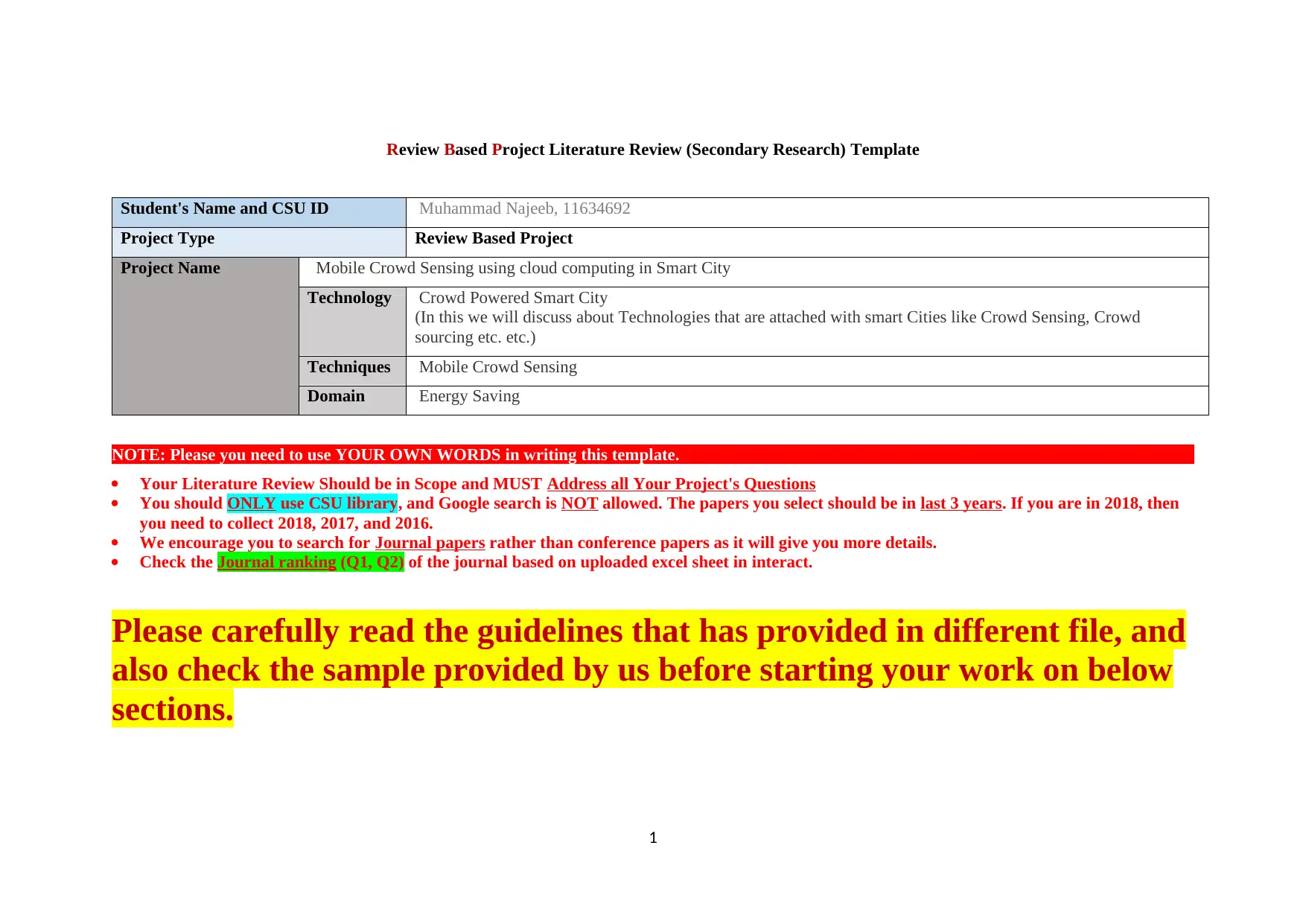
Review Based Project Literature Review (Secondary Research) Template
Student's Name and CSU ID Muhammad Najeeb, 11634692
Project Type Review Based Project
Project Name Mobile Crowd Sensing using cloud computing in Smart City
Technology Crowd Powered Smart City
(In this we will discuss about Technologies that are attached with smart Cities like Crowd Sensing, Crowd
sourcing etc. etc.)
Techniques Mobile Crowd Sensing
Domain Energy Saving
NOTE: Please you need to use YOUR OWN WORDS in writing this template.
Your Literature Review Should be in Scope and MUST Address all Your Project's Questions
You should ONLY use CSU library, and Google search is NOT allowed. The papers you select should be in last 3 years. If you are in 2018, then
you need to collect 2018, 2017, and 2016.
We encourage you to search for Journal papers rather than conference papers as it will give you more details.
Check the Journal ranking (Q1, Q2) of the journal based on uploaded excel sheet in interact.
Please carefully read the guidelines that has provided in different file, and
also check the sample provided by us before starting your work on below
sections.
1
Student's Name and CSU ID Muhammad Najeeb, 11634692
Project Type Review Based Project
Project Name Mobile Crowd Sensing using cloud computing in Smart City
Technology Crowd Powered Smart City
(In this we will discuss about Technologies that are attached with smart Cities like Crowd Sensing, Crowd
sourcing etc. etc.)
Techniques Mobile Crowd Sensing
Domain Energy Saving
NOTE: Please you need to use YOUR OWN WORDS in writing this template.
Your Literature Review Should be in Scope and MUST Address all Your Project's Questions
You should ONLY use CSU library, and Google search is NOT allowed. The papers you select should be in last 3 years. If you are in 2018, then
you need to collect 2018, 2017, and 2016.
We encourage you to search for Journal papers rather than conference papers as it will give you more details.
Check the Journal ranking (Q1, Q2) of the journal based on uploaded excel sheet in interact.
Please carefully read the guidelines that has provided in different file, and
also check the sample provided by us before starting your work on below
sections.
1
Paraphrase This Document
Need a fresh take? Get an instant paraphrase of this document with our AI Paraphraser

1
Reference in APA format that will be in
'Reference List'
(This give the Reference of the Journal
Paper you are working on it)
Capponi, C. Fiandrino, D. Kliazovich, P. Bouvry and S. Giordano (2017). A Cost-Effective Distributed
Framework for Data Collection in Cloud-Based Mobile Crowd Sensing Architectures. IEEE Transactions on
Sustainable Computing 2(1) pp 3-16
DOI: 10.1109/TSUSC.2017.2666043
IEEE Transactions on Sustainable Computing
Citation that will be in the content (Capponi et al, 2017)
URL of the Reference Level of Journal (Q1, Q2, …Qn) Keywords in this Reference
https://ieeexplore-ieee-
org.ezproxy.csu.edu.au/document/7847440
Q1 Mobile crowd sensing, energy-efficient data collection,
opportunistic sensing
The Name of the Current Solution
(Technique/ Method/ Scheme/
Algorithm/ Model/ Tool/ Framework/ ...
etc )
The Goal (Objective) of this Solution &
What is the Problem that need to be solved
What are the components of it?
Technique/Algorithm name:
Amount of collected data and energy cost
for sensing and reporting have been taken
in as performance evaluation
characteristics. While the simulator
evaluates and assesses the efficiency of
proposed framework with a large number
of participants
Tools:
Custom Cloud sensing simulator has been
Problem: There is a requirement to
investigate data collection policies keeping a
cost effective framework in cloud based
mobile crowd sensing architectures
Goal: To develop a new data collection
framework for opportunistic cloud based
systems
Mobile Devices
Sustainable Data gathering framework
Mobile Crowd Sensing
Internet of Things
S2aaS models
Study of Data Collection Policies
2
Reference in APA format that will be in
'Reference List'
(This give the Reference of the Journal
Paper you are working on it)
Capponi, C. Fiandrino, D. Kliazovich, P. Bouvry and S. Giordano (2017). A Cost-Effective Distributed
Framework for Data Collection in Cloud-Based Mobile Crowd Sensing Architectures. IEEE Transactions on
Sustainable Computing 2(1) pp 3-16
DOI: 10.1109/TSUSC.2017.2666043
IEEE Transactions on Sustainable Computing
Citation that will be in the content (Capponi et al, 2017)
URL of the Reference Level of Journal (Q1, Q2, …Qn) Keywords in this Reference
https://ieeexplore-ieee-
org.ezproxy.csu.edu.au/document/7847440
Q1 Mobile crowd sensing, energy-efficient data collection,
opportunistic sensing
The Name of the Current Solution
(Technique/ Method/ Scheme/
Algorithm/ Model/ Tool/ Framework/ ...
etc )
The Goal (Objective) of this Solution &
What is the Problem that need to be solved
What are the components of it?
Technique/Algorithm name:
Amount of collected data and energy cost
for sensing and reporting have been taken
in as performance evaluation
characteristics. While the simulator
evaluates and assesses the efficiency of
proposed framework with a large number
of participants
Tools:
Custom Cloud sensing simulator has been
Problem: There is a requirement to
investigate data collection policies keeping a
cost effective framework in cloud based
mobile crowd sensing architectures
Goal: To develop a new data collection
framework for opportunistic cloud based
systems
Mobile Devices
Sustainable Data gathering framework
Mobile Crowd Sensing
Internet of Things
S2aaS models
Study of Data Collection Policies
2

build
Applied Area:
smartphones, tablets, and wearable devices
The Process (Mechanism) of this Work; The process steps of the Technique/system
Process Steps Advantage (Purpose of this step) Disadvantage (Limitation/Challenge)
1 Performance Evaluation For the matter, battery remaining percentage,
as to quantify to contribution levels at high and
low battery charges.
To Evaluate all sensing equipment such as
accelerometer, temperature and pressure and
other communication devices
N/A
2 Simulation Evaluation and Setup To quantify the amount of information
collected versus energy cost consumed while
data reporting
N/A
Validation Criteria (Measurement Criteria)
Dependent Variable Independent Variable
Data (Byte) Variable users with variable initial charge
Data (Byte) Analysis as per accelerometer, temperature and pressure
Energy Consumptions, Energy Cost Number of users
Mobility trace density Time intervals
3
Applied Area:
smartphones, tablets, and wearable devices
The Process (Mechanism) of this Work; The process steps of the Technique/system
Process Steps Advantage (Purpose of this step) Disadvantage (Limitation/Challenge)
1 Performance Evaluation For the matter, battery remaining percentage,
as to quantify to contribution levels at high and
low battery charges.
To Evaluate all sensing equipment such as
accelerometer, temperature and pressure and
other communication devices
N/A
2 Simulation Evaluation and Setup To quantify the amount of information
collected versus energy cost consumed while
data reporting
N/A
Validation Criteria (Measurement Criteria)
Dependent Variable Independent Variable
Data (Byte) Variable users with variable initial charge
Data (Byte) Analysis as per accelerometer, temperature and pressure
Energy Consumptions, Energy Cost Number of users
Mobility trace density Time intervals
3
⊘ This is a preview!⊘
Do you want full access?
Subscribe today to unlock all pages.

Trusted by 1+ million students worldwide
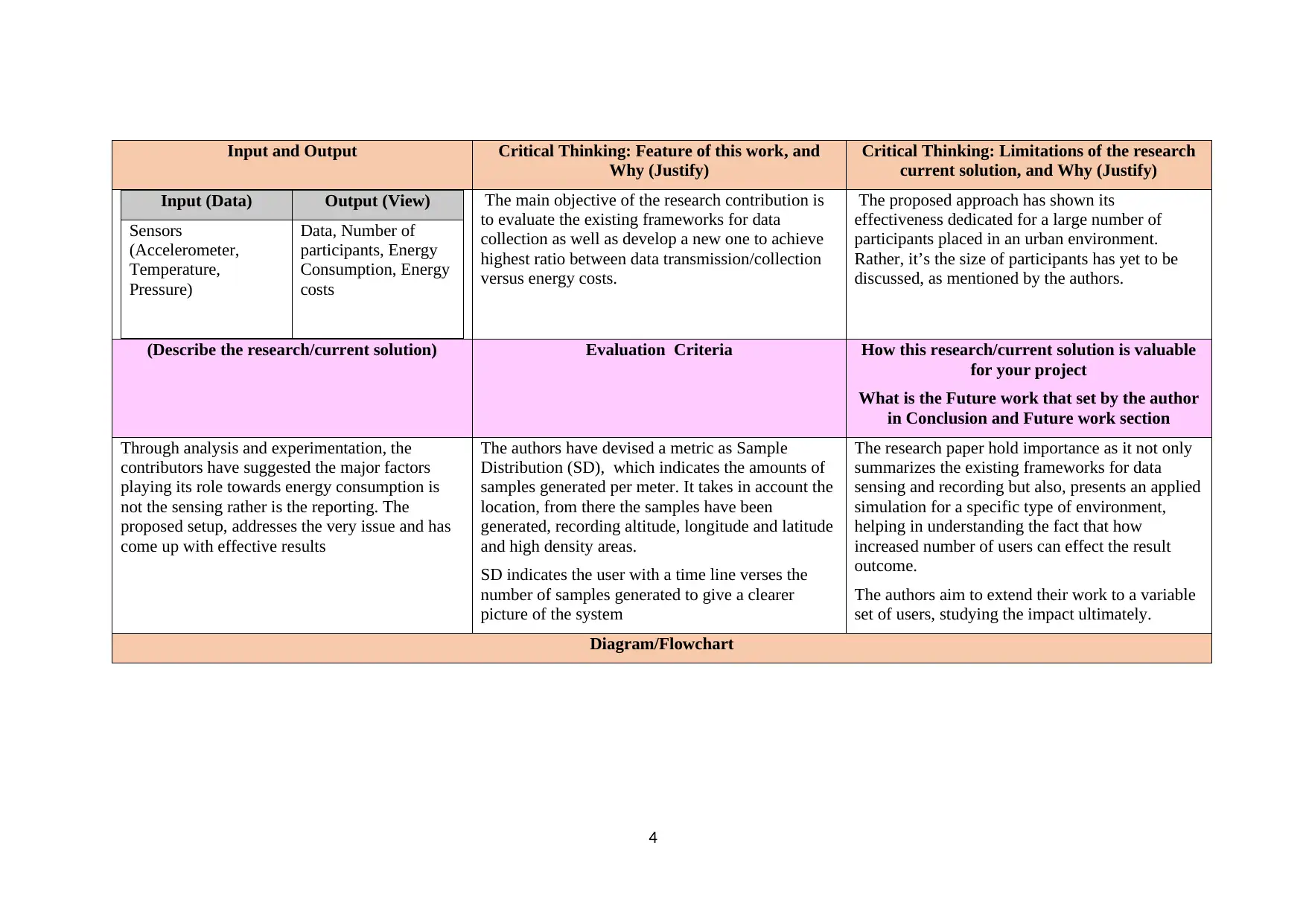
Input and Output Critical Thinking: Feature of this work, and
Why (Justify)
Critical Thinking: Limitations of the research
current solution, and Why (Justify)
Input (Data) Output (View)
Sensors
(Accelerometer,
Temperature,
Pressure)
Data, Number of
participants, Energy
Consumption, Energy
costs
The main objective of the research contribution is
to evaluate the existing frameworks for data
collection as well as develop a new one to achieve
highest ratio between data transmission/collection
versus energy costs.
The proposed approach has shown its
effectiveness dedicated for a large number of
participants placed in an urban environment.
Rather, it’s the size of participants has yet to be
discussed, as mentioned by the authors.
(Describe the research/current solution) Evaluation Criteria How this research/current solution is valuable
for your project
What is the Future work that set by the author
in Conclusion and Future work section
Through analysis and experimentation, the
contributors have suggested the major factors
playing its role towards energy consumption is
not the sensing rather is the reporting. The
proposed setup, addresses the very issue and has
come up with effective results
The authors have devised a metric as Sample
Distribution (SD), which indicates the amounts of
samples generated per meter. It takes in account the
location, from there the samples have been
generated, recording altitude, longitude and latitude
and high density areas.
SD indicates the user with a time line verses the
number of samples generated to give a clearer
picture of the system
The research paper hold importance as it not only
summarizes the existing frameworks for data
sensing and recording but also, presents an applied
simulation for a specific type of environment,
helping in understanding the fact that how
increased number of users can effect the result
outcome.
The authors aim to extend their work to a variable
set of users, studying the impact ultimately.
Diagram/Flowchart
4
Why (Justify)
Critical Thinking: Limitations of the research
current solution, and Why (Justify)
Input (Data) Output (View)
Sensors
(Accelerometer,
Temperature,
Pressure)
Data, Number of
participants, Energy
Consumption, Energy
costs
The main objective of the research contribution is
to evaluate the existing frameworks for data
collection as well as develop a new one to achieve
highest ratio between data transmission/collection
versus energy costs.
The proposed approach has shown its
effectiveness dedicated for a large number of
participants placed in an urban environment.
Rather, it’s the size of participants has yet to be
discussed, as mentioned by the authors.
(Describe the research/current solution) Evaluation Criteria How this research/current solution is valuable
for your project
What is the Future work that set by the author
in Conclusion and Future work section
Through analysis and experimentation, the
contributors have suggested the major factors
playing its role towards energy consumption is
not the sensing rather is the reporting. The
proposed setup, addresses the very issue and has
come up with effective results
The authors have devised a metric as Sample
Distribution (SD), which indicates the amounts of
samples generated per meter. It takes in account the
location, from there the samples have been
generated, recording altitude, longitude and latitude
and high density areas.
SD indicates the user with a time line verses the
number of samples generated to give a clearer
picture of the system
The research paper hold importance as it not only
summarizes the existing frameworks for data
sensing and recording but also, presents an applied
simulation for a specific type of environment,
helping in understanding the fact that how
increased number of users can effect the result
outcome.
The authors aim to extend their work to a variable
set of users, studying the impact ultimately.
Diagram/Flowchart
4
Paraphrase This Document
Need a fresh take? Get an instant paraphrase of this document with our AI Paraphraser
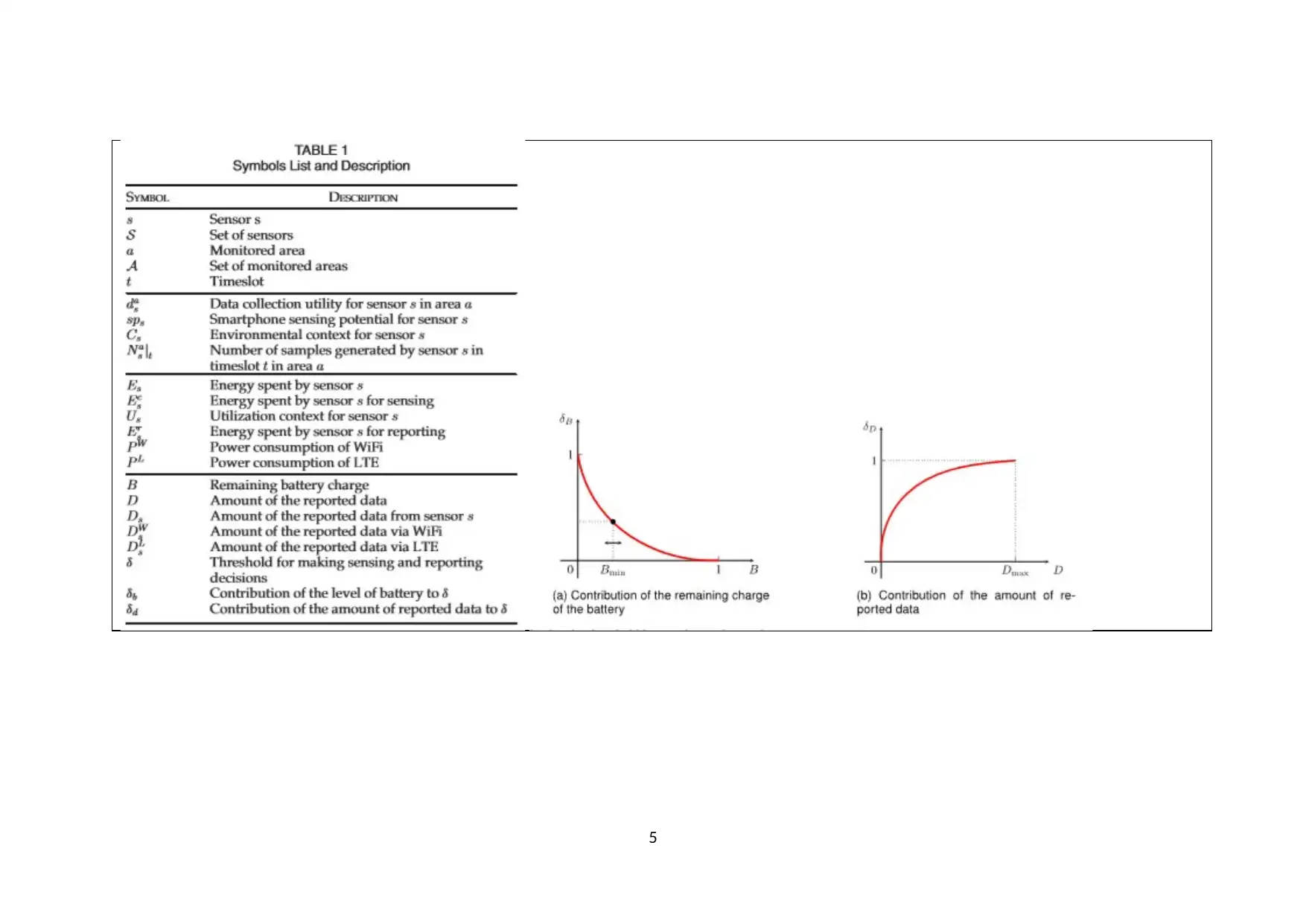
5
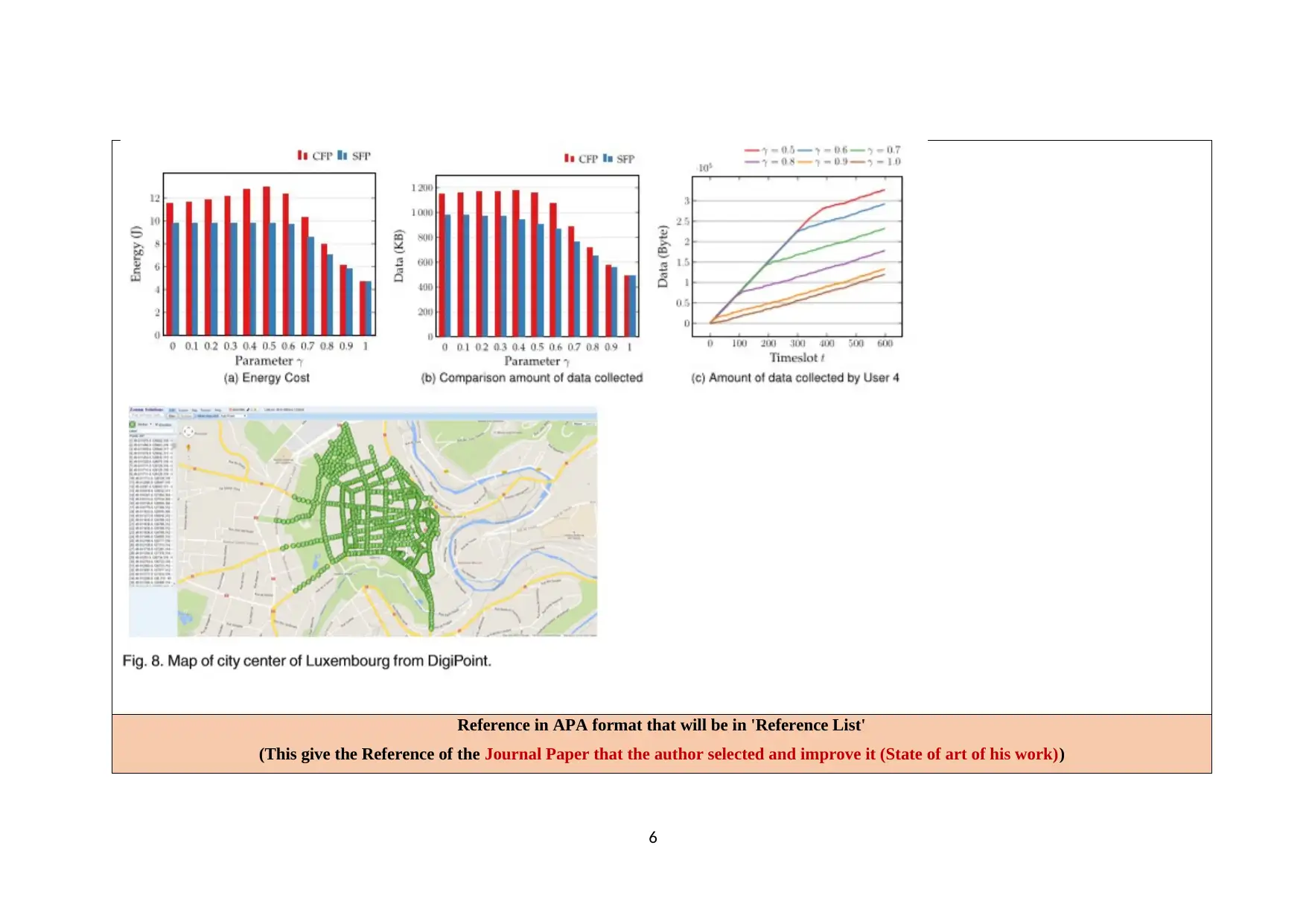
Reference in APA format that will be in 'Reference List'
(This give the Reference of the Journal Paper that the author selected and improve it (State of art of his work))
6
(This give the Reference of the Journal Paper that the author selected and improve it (State of art of his work))
6
⊘ This is a preview!⊘
Do you want full access?
Subscribe today to unlock all pages.

Trusted by 1+ million students worldwide
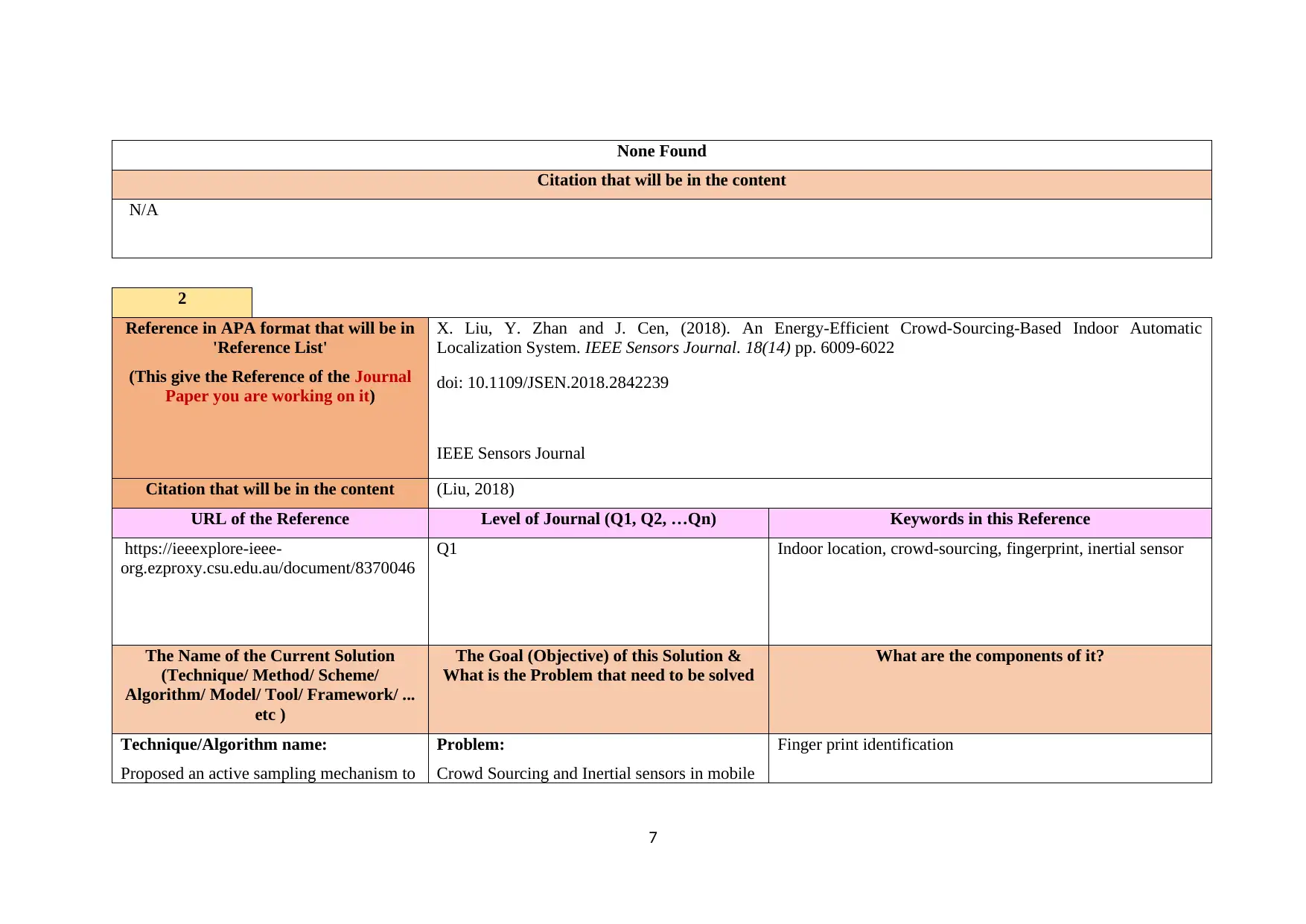
None Found
Citation that will be in the content
N/A
2
Reference in APA format that will be in
'Reference List'
(This give the Reference of the Journal
Paper you are working on it)
X. Liu, Y. Zhan and J. Cen, (2018). An Energy-Efficient Crowd-Sourcing-Based Indoor Automatic
Localization System. IEEE Sensors Journal. 18(14) pp. 6009-6022
doi: 10.1109/JSEN.2018.2842239
IEEE Sensors Journal
Citation that will be in the content (Liu, 2018)
URL of the Reference Level of Journal (Q1, Q2, …Qn) Keywords in this Reference
https://ieeexplore-ieee-
org.ezproxy.csu.edu.au/document/8370046
Q1 Indoor location, crowd-sourcing, fingerprint, inertial sensor
The Name of the Current Solution
(Technique/ Method/ Scheme/
Algorithm/ Model/ Tool/ Framework/ ...
etc )
The Goal (Objective) of this Solution &
What is the Problem that need to be solved
What are the components of it?
Technique/Algorithm name:
Proposed an active sampling mechanism to
Problem:
Crowd Sourcing and Inertial sensors in mobile
Finger print identification
7
Citation that will be in the content
N/A
2
Reference in APA format that will be in
'Reference List'
(This give the Reference of the Journal
Paper you are working on it)
X. Liu, Y. Zhan and J. Cen, (2018). An Energy-Efficient Crowd-Sourcing-Based Indoor Automatic
Localization System. IEEE Sensors Journal. 18(14) pp. 6009-6022
doi: 10.1109/JSEN.2018.2842239
IEEE Sensors Journal
Citation that will be in the content (Liu, 2018)
URL of the Reference Level of Journal (Q1, Q2, …Qn) Keywords in this Reference
https://ieeexplore-ieee-
org.ezproxy.csu.edu.au/document/8370046
Q1 Indoor location, crowd-sourcing, fingerprint, inertial sensor
The Name of the Current Solution
(Technique/ Method/ Scheme/
Algorithm/ Model/ Tool/ Framework/ ...
etc )
The Goal (Objective) of this Solution &
What is the Problem that need to be solved
What are the components of it?
Technique/Algorithm name:
Proposed an active sampling mechanism to
Problem:
Crowd Sourcing and Inertial sensors in mobile
Finger print identification
7
Paraphrase This Document
Need a fresh take? Get an instant paraphrase of this document with our AI Paraphraser

filter reliable and useful information for
users’ inputs.
Tools:
Networking hardware
Applied Area:
Finger print based Locations
devices have their own set of problems both,
theoretically and practically. The proposed
work aims to address those very problems.
Goal:
To develop an approach to achieve higher
room level localization accuracy and reduced
energy consumption
Indoor navigation
Room level localization
Virtual room generation mechanism
The Process (Mechanism) of this Work; The process steps of the Technique/system
Process Steps Advantage (Purpose of this step) Disadvantage (Limitation/Challenge)
1 Active Sampling Algorithm To achieve user motion detection
Data acquision and process control
Data storage and ultimately transmission of it.
N/A
2 Fingerprint processing Pre-processing of the data (fingerprint)
RSSI clustering based on dissimilarities
AP based hotspots RSSI Clustering
Virtual room generation
Floor Plan mapping
N/A
Validation Criteria (Measurement Criteria)
Dependent Variable Independent Variable
Average Received Signal Strength Indicators (RSSI) Time
8
users’ inputs.
Tools:
Networking hardware
Applied Area:
Finger print based Locations
devices have their own set of problems both,
theoretically and practically. The proposed
work aims to address those very problems.
Goal:
To develop an approach to achieve higher
room level localization accuracy and reduced
energy consumption
Indoor navigation
Room level localization
Virtual room generation mechanism
The Process (Mechanism) of this Work; The process steps of the Technique/system
Process Steps Advantage (Purpose of this step) Disadvantage (Limitation/Challenge)
1 Active Sampling Algorithm To achieve user motion detection
Data acquision and process control
Data storage and ultimately transmission of it.
N/A
2 Fingerprint processing Pre-processing of the data (fingerprint)
RSSI clustering based on dissimilarities
AP based hotspots RSSI Clustering
Virtual room generation
Floor Plan mapping
N/A
Validation Criteria (Measurement Criteria)
Dependent Variable Independent Variable
Average Received Signal Strength Indicators (RSSI) Time
8

Average RSSI Sampling Numbers
Parity of Unity, Accuracy Days, Users
Standby Time Indoor Location System
Power Consumption Sampling Frequency
Input and Output Critical Thinking: Feature of this work, and
Why (Justify)
Critical Thinking: Limitations of the research
current solution, and Why (Justify)
Input (Data) Output (View)
Accelerometer, RSSI active sampling
algorithm, Fingerprint
processing
The proposed work stands out for its contribution
as it has presented an active sampling algorithm
that filters the reliable information from many users
without compromising on the quality based on
incentives.
The fingerprint database adaptation to encounter
the indoor harsh environment and its dynamics has
been discussed in the under discussion literature.
(Describe the research/current solution) Evaluation Criteria How this research/current solution is valuable
for your project
What is the Future work that set by the author
in Conclusion and Future work section
The pre-existing algorithms produce extensive
and complex computations used by PDR or
SLMA techniques with a Nosie error also present
in them. Yet the fingerprint database constructed
here has been using data collection from
stationary hotspots and divides them into virtual
rooms using data collected from participants’
movements
Better results have been achieved, after applying
the presented algorithm to a typical indoor
application.
The performance was evaluate by its application to
two typical environments with 802.11b WLAN
infrastructure with one environment being an office
building with reinforced concrete walls, floors and
ceilings while the other being a newly constructed
shopping mall with metal studded dry wall and
wooden doors.
In the literature pool there exist algorithms that
pose complex computations and extended
calculations. The proposed system not only
counters the issue but also presents one, with
higher energy efficiency.
The authors of the under-discussion literature,
target an improved performance during inception
and updating phase as their future research area.
9
Parity of Unity, Accuracy Days, Users
Standby Time Indoor Location System
Power Consumption Sampling Frequency
Input and Output Critical Thinking: Feature of this work, and
Why (Justify)
Critical Thinking: Limitations of the research
current solution, and Why (Justify)
Input (Data) Output (View)
Accelerometer, RSSI active sampling
algorithm, Fingerprint
processing
The proposed work stands out for its contribution
as it has presented an active sampling algorithm
that filters the reliable information from many users
without compromising on the quality based on
incentives.
The fingerprint database adaptation to encounter
the indoor harsh environment and its dynamics has
been discussed in the under discussion literature.
(Describe the research/current solution) Evaluation Criteria How this research/current solution is valuable
for your project
What is the Future work that set by the author
in Conclusion and Future work section
The pre-existing algorithms produce extensive
and complex computations used by PDR or
SLMA techniques with a Nosie error also present
in them. Yet the fingerprint database constructed
here has been using data collection from
stationary hotspots and divides them into virtual
rooms using data collected from participants’
movements
Better results have been achieved, after applying
the presented algorithm to a typical indoor
application.
The performance was evaluate by its application to
two typical environments with 802.11b WLAN
infrastructure with one environment being an office
building with reinforced concrete walls, floors and
ceilings while the other being a newly constructed
shopping mall with metal studded dry wall and
wooden doors.
In the literature pool there exist algorithms that
pose complex computations and extended
calculations. The proposed system not only
counters the issue but also presents one, with
higher energy efficiency.
The authors of the under-discussion literature,
target an improved performance during inception
and updating phase as their future research area.
9
⊘ This is a preview!⊘
Do you want full access?
Subscribe today to unlock all pages.

Trusted by 1+ million students worldwide
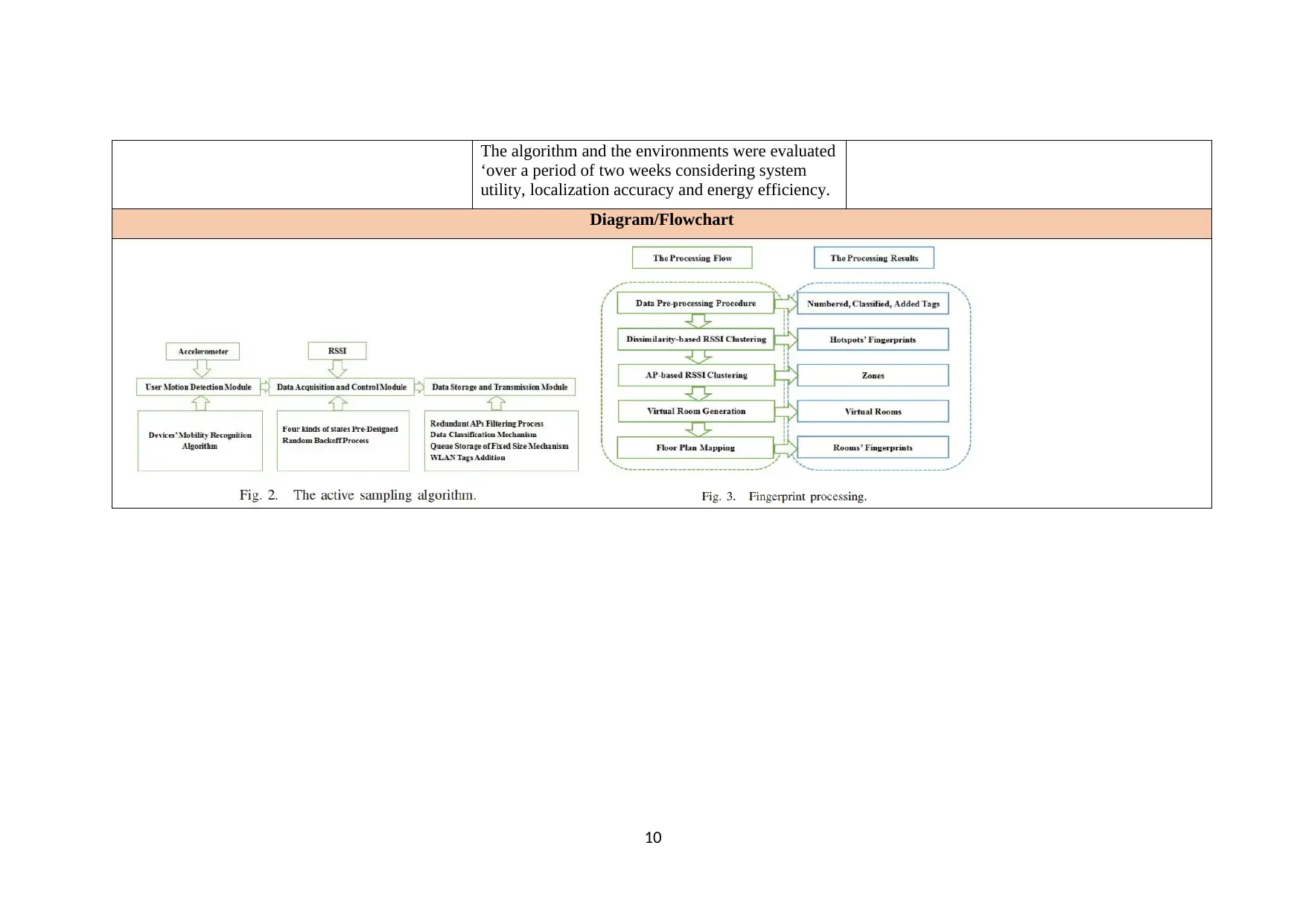
The algorithm and the environments were evaluated
‘over a period of two weeks considering system
utility, localization accuracy and energy efficiency.
Diagram/Flowchart
10
‘over a period of two weeks considering system
utility, localization accuracy and energy efficiency.
Diagram/Flowchart
10
Paraphrase This Document
Need a fresh take? Get an instant paraphrase of this document with our AI Paraphraser

11

Reference in APA format that will be in 'Reference List'
(This give the Reference of the Journal Paper that the author selected and improve it (State of art of his work))
None Found
Citation that will be in the content
N/A
Version 2.0 _ Week 2 (5 Journal Papers from CSU Library)
12
(This give the Reference of the Journal Paper that the author selected and improve it (State of art of his work))
None Found
Citation that will be in the content
N/A
Version 2.0 _ Week 2 (5 Journal Papers from CSU Library)
12
⊘ This is a preview!⊘
Do you want full access?
Subscribe today to unlock all pages.

Trusted by 1+ million students worldwide
1 out of 134
Related Documents
Your All-in-One AI-Powered Toolkit for Academic Success.
+13062052269
info@desklib.com
Available 24*7 on WhatsApp / Email
![[object Object]](/_next/static/media/star-bottom.7253800d.svg)
Unlock your academic potential
Copyright © 2020–2025 A2Z Services. All Rights Reserved. Developed and managed by ZUCOL.




